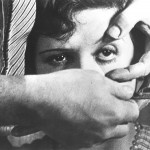Over the years, I have, of course, heard and read a great deal about Luis Bunuel’s surrealist masterpiece, Un Chien Andalou (1929), but until Friday I had never actually seen it. Created in collaboration with Salvador Dali, Bunuel’s first film is most remembered today for one of its opening sequences, which cuts between shots of a razor blade, a woman whose left eye is being forced open, and a thin line of clouds passing before a full moon. Just as we’ve become convinced that the cloud and moon will serve as a symbolic gesture, comfortably eliding the violence implied by the sequence, Bunuel cuts to a close-up of the eyeball being sliced open. The scene still works, more than seven decades later.
My favorite discussion of the sequence can be found in Virginia Carmichael’s Framing History, where she compares Bunuel’s film to E.L. Doctorow’s The Book of Daniel, a novel that attempts to make sense of the early Cold War years. There’s a remarkable and disturbing moment in the novel when the title character reaches over to burn his young wife with a car cigarette lighter. Instead of showing the horrible scene, though, Doctorow (through his narrator) attacks the reader, writing:
Shall I continue? Do you want to know the effect of three concentric circles of heating element glowing orange in the black night of rain upon the tender white girlflesh of my wife’s ass? Who are you anyway? Who told you you could read this? Is nothing sacred? (60)
Carmichael on the scene:
What seems merely gratuitous cinematographic aestheticism on Bunuel’s part becomes something more radically critical in a political sense when considered as [Daniel’s] symbolic discovery of the function of symbolism in history to mask the horrors of reality—realities such as Stalin’s purges, the U.S. government’s knowing exposure of government workers to high-level radiation. (143)
So much of contemporary filmmaking is about misdirection, about exciting the emotions and disregarding the consequences. I appreciate Bunuel’s film for its refusal to let us off so easily, though I must admit that, as with so much of Modernist surrealism, I found myself often stunned by the images but unwilling to engage in the intellectual gamesmanship necessary to decode them. I’m sure that great articles have been written that carefully trace contours through the fifteen minute film, but I couldn’t find the motivation to do so myself.
